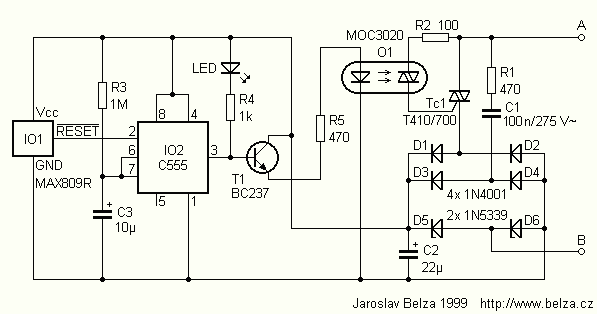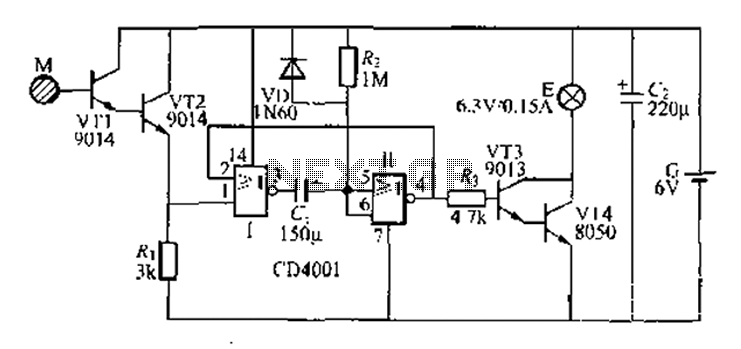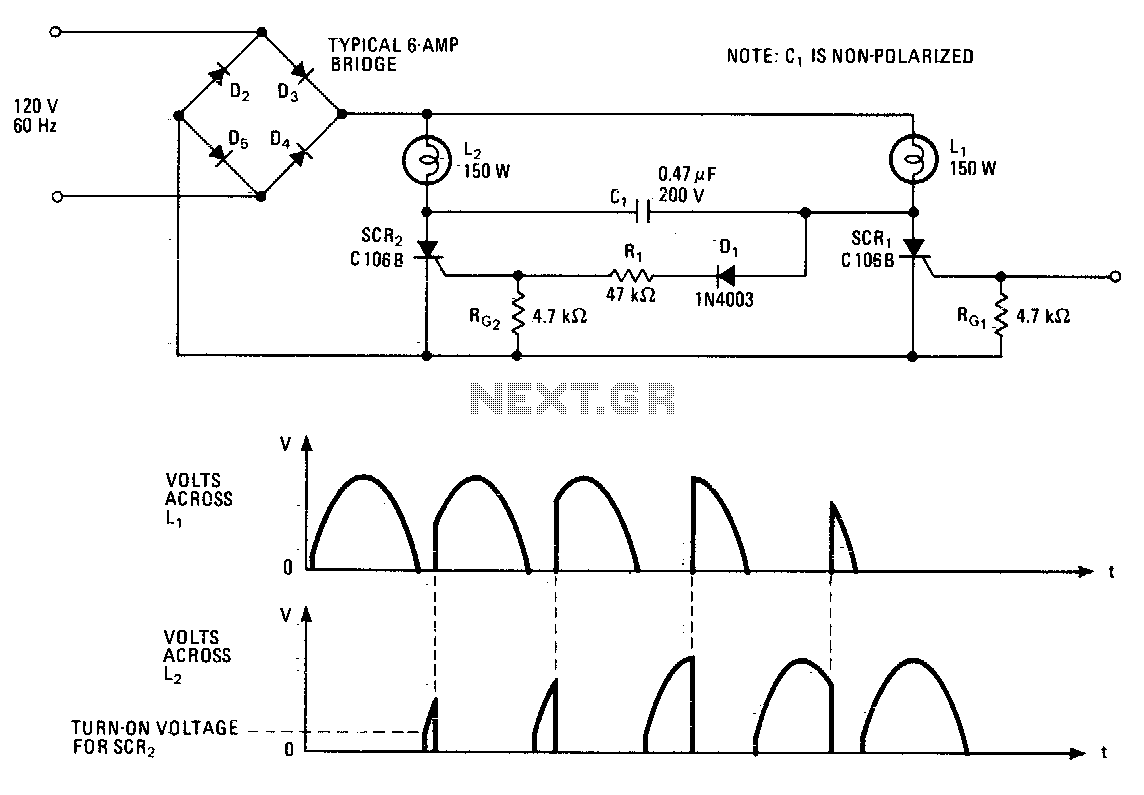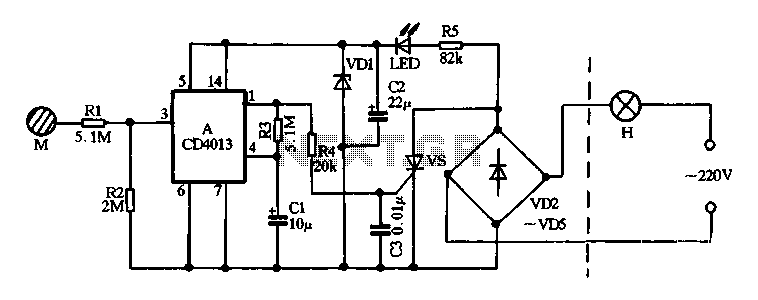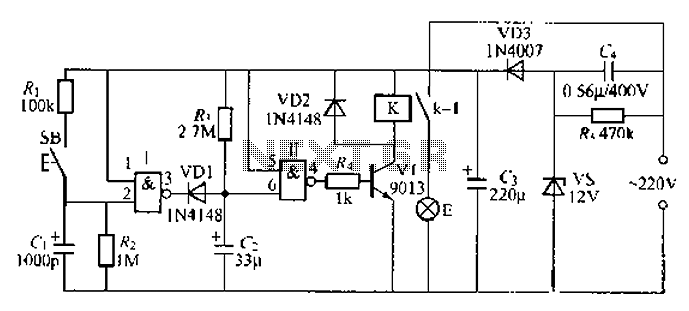
Vehicle Interior Lighting With Switch-Off Delay
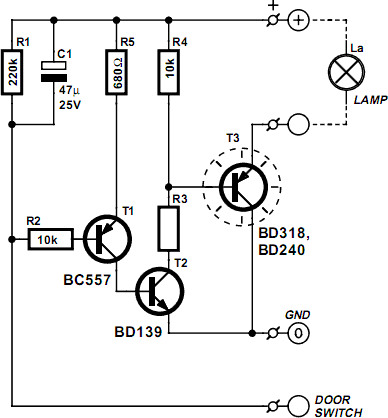
Nowadays, a switch-off delay for vehicle interior lighting is a standard feature. However, certain models with minimal settings or older vehicles leave users in the dark as soon as they enter and close the door. This situation calls for an aftermarket solution. The circuit was constructed using standard components with leads, arranged in a surface-mount device (SMD) style, meaning the components are fitted on the copper side. Only four mounting holes were drilled into the circuit board, and the entire assembly was securely attached to the surface of a heatsink for power transistor T3, which is a finned heatsink rated at 7.2 °C/W. The heatsink is at ground potential. A resistance value of 1 ohm was used for R3, ensuring satisfactory performance of the Darlington transistor. The interior light activates when the door is opened and remains illuminated at full brightness for approximately 30 seconds after the door is closed, gradually dimming thereafter. Around one minute after the door is closed, the quiescent current drops to zero.
The described circuit serves as an effective solution for vehicles lacking an integrated delay feature for interior lighting. The design utilizes a Darlington transistor configuration, which is known for its high current gain, making it suitable for controlling the interior light with minimal input current. The use of a heatsink for the power transistor T3 is critical, as it dissipates heat generated during operation, ensuring the transistor operates within safe thermal limits.
The circuit board layout is optimized for SMD assembly, which helps in reducing the overall footprint and enhancing reliability. The four mounting holes provide robust mechanical support, ensuring that the assembly remains securely attached to the heatsink, which also serves as a common ground reference.
The operation sequence begins when the vehicle door is opened, triggering the circuit to power the interior light. The initial bright illumination for 30 seconds allows for visibility when entering the vehicle. Following this, the gradual dimming of the light creates a softer ambiance, preventing abrupt darkness and enhancing user comfort.
The design's quiescent current dropping to zero after one minute signifies that the circuit is energy-efficient, as it prevents battery drain when the vehicle is not in use. This feature is particularly beneficial for older vehicles that may not have modern power management systems. The circuit is suitable for aftermarket installation, providing a valuable enhancement to the vehicle's existing electrical system.Nowadays, a switch-off delay for the vehicle interior lighting is a naturally a standard feature. However, with certain models having only spartanttings, or older-model vehicles, you`re left sitting in the dark as soon as you climb in and close the door. That calls for an aftermarket accessory! The author built this circuit using normal` compo nents (with leads), but in the SMD manner, which meanstting the components on the copper side. The only holes drilled in the circuit board were the fourxing holes, and the entire assembly wasrmly attached to the surface of the heatsink for power transistor T3 (the author used a finned heat sink rated at 7. 2 °C/W). The heatsink is at ground potential. A value of 1 was used for R3 with satisfactory operation of the darlington. The light goes on when the door is opened. After the door is closed, it continues to illuminate the interior of the car at full brightness for around 30 seconds, after which it slowly dims.
Approximately 1 minute after the door is closed, the quiescent current drops to zero. 🔗 External reference
The described circuit serves as an effective solution for vehicles lacking an integrated delay feature for interior lighting. The design utilizes a Darlington transistor configuration, which is known for its high current gain, making it suitable for controlling the interior light with minimal input current. The use of a heatsink for the power transistor T3 is critical, as it dissipates heat generated during operation, ensuring the transistor operates within safe thermal limits.
The circuit board layout is optimized for SMD assembly, which helps in reducing the overall footprint and enhancing reliability. The four mounting holes provide robust mechanical support, ensuring that the assembly remains securely attached to the heatsink, which also serves as a common ground reference.
The operation sequence begins when the vehicle door is opened, triggering the circuit to power the interior light. The initial bright illumination for 30 seconds allows for visibility when entering the vehicle. Following this, the gradual dimming of the light creates a softer ambiance, preventing abrupt darkness and enhancing user comfort.
The design's quiescent current dropping to zero after one minute signifies that the circuit is energy-efficient, as it prevents battery drain when the vehicle is not in use. This feature is particularly beneficial for older vehicles that may not have modern power management systems. The circuit is suitable for aftermarket installation, providing a valuable enhancement to the vehicle's existing electrical system.Nowadays, a switch-off delay for the vehicle interior lighting is a naturally a standard feature. However, with certain models having only spartanttings, or older-model vehicles, you`re left sitting in the dark as soon as you climb in and close the door. That calls for an aftermarket accessory! The author built this circuit using normal` compo nents (with leads), but in the SMD manner, which meanstting the components on the copper side. The only holes drilled in the circuit board were the fourxing holes, and the entire assembly wasrmly attached to the surface of the heatsink for power transistor T3 (the author used a finned heat sink rated at 7. 2 °C/W). The heatsink is at ground potential. A value of 1 was used for R3 with satisfactory operation of the darlington. The light goes on when the door is opened. After the door is closed, it continues to illuminate the interior of the car at full brightness for around 30 seconds, after which it slowly dims.
Approximately 1 minute after the door is closed, the quiescent current drops to zero. 🔗 External reference
Warning: include(partials/cookie-banner.php): Failed to open stream: Permission denied in /var/www/html/nextgr/view-circuit.php on line 713
Warning: include(): Failed opening 'partials/cookie-banner.php' for inclusion (include_path='.:/usr/share/php') in /var/www/html/nextgr/view-circuit.php on line 713
